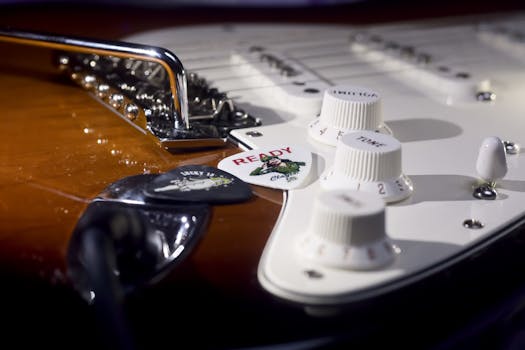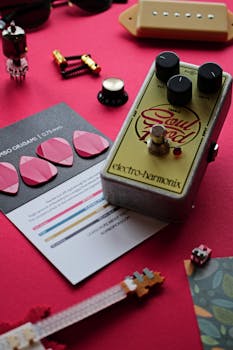Mastering Guitar Tone Shaping: A Comprehensive Guide
Introduction
Achieving the perfect guitar tone is a journey that every guitarist embarks on. Whether you’re a beginner or a seasoned player, understanding how to shape your guitar tone is essential for crafting your unique sound. This guide will delve into the intricacies of guitar tone shaping, covering everything from the basics of tone, the role of different guitar components, and the impact of external gear. By the end, you’ll be equipped with the knowledge to refine and personalize your guitar sound to perfection.
What is Guitar Tone Shaping?
The Basics of Guitar Tone

Guitar tone refers to the quality and character of the sound produced by a guitar. This encompasses a wide range of elements including pitch, timbre, and dynamics. Tone shaping, therefore, is the process of adjusting these elements to achieve a desired sound.
Why Guitar Tone Matters
The tone of a guitar is crucial because it defines the overall sound and feel of the music being played. It can distinguish genres, evoke emotions, and highlight the guitarist’s style. A well-shaped tone can enhance a performance, making the guitar stand out or blend seamlessly with other instruments.
The Components of Guitar Tone
Guitar Body and Wood Type
The body of the guitar and the wood used in its construction play a significant role in tone shaping. Different woods produce different tonal qualities:
- Mahogany: Known for its warm and full tone, mahogany offers excellent sustain and depth.
- Alder: Provides a balanced tone with a strong midrange, often found in Fender guitars.
- Maple: Offers bright and clear tones with good sustain, commonly used for necks and fretboards.
Pickups and Electronics
Pickups are crucial in converting string vibrations into electrical signals. The type of pickups can drastically alter the tone:
- Single-Coil Pickups: Deliver a bright, crisp sound with more clarity and bite, often associated with classic rock and blues.
- Humbucker Pickups: Known for their thick, warm sound and higher output, making them popular in rock and metal genres.
- P90 Pickups: Sit between single-coils and humbuckers, offering a balanced tone with both clarity and warmth.
Strings and Setup
The type of strings and the setup of the guitar also affect tone. Thicker strings typically produce a fuller sound with more sustain, while thinner strings offer a brighter, lighter tone. The guitar’s setup, including action and intonation, ensures that it plays in tune and feels comfortable, allowing for optimal tone production.
External Gear and Tone Shaping
Amplifiers
Amplifiers are perhaps the most influential external factor in tone shaping. Different types of amplifiers can produce vastly different sounds:
- Tube Amplifiers: Known for their warm, rich tones and dynamic response. They are favored for their natural compression and harmonic overtones.
- Solid-State Amplifiers: Offer a more consistent sound with greater reliability and are often more affordable. They provide a cleaner tone that many jazz and pop players prefer.
- Modeling Amplifiers: Use digital technology to emulate the sound of various amp types, offering great versatility and convenience.
Effects Pedals

Effects pedals are a guitarist’s playground for tone shaping. Each pedal alters the guitar’s signal in a specific way:
- Overdrive/Distortion Pedals: Add grit and sustain, crucial for rock and metal tones.
- Reverb and Delay Pedals: Create space and depth, essential for ambient and atmospheric sounds.
- Modulation Pedals (Chorus, Flanger, Phaser): Add movement and texture to the tone, widely used in various genres for their unique effects.
Cables and Connectors
While often overlooked, the quality of cables and connectors can impact the tone. High-quality cables ensure a clean signal path with minimal noise and signal loss, preserving the integrity of your tone.
Techniques for Shaping Guitar Tone
Adjusting Amp Settings
Learning to adjust your amplifier settings is fundamental for tone shaping. Key settings include:
- Gain: Controls the amount of distortion. Higher gain settings result in more drive and sustain, while lower settings produce a cleaner tone.
- EQ (Bass, Mid, Treble): Allows fine-tuning of the frequency response. Boosting or cutting these frequencies can drastically change the tone.
- Presence and Master Volume: Further refine the overall tone and loudness. Presence adds high-end sparkle, while the master volume controls the overall output level.
Using Pedals Effectively
Knowing how to stack and sequence pedals is essential for achieving desired effects:
- Signal Chain Order: Typically, distortion and overdrive pedals go first, followed by modulation effects, and then time-based effects like reverb and delay.
- Pedal Combinations: Experimenting with different pedal combinations can lead to unique tones. For example, using a compressor before a distortion pedal can add sustain and smooth out the dynamics.
Playing Techniques
Your playing style and technique also shape your tone. Techniques such as:
- Picking Dynamics: Harder picking produces a more aggressive tone, while lighter picking results in a softer, cleaner sound.
- Palm Muting: Creates a percussive, choppy sound, essential for genres like metal and punk.
- Fingerpicking: Offers a warmer, more intimate tone compared to using a pick.
Advanced Tone Shaping Concepts
Tone Stacking
Tone stacking involves using multiple layers of tone-shaping tools, such as combining different amps or using a complex pedal setup, to create a rich, multifaceted sound. This technique is often used in recording studios to achieve professional-quality tones.
Impedance Matching
Understanding and managing impedance matching between your guitar, pedals, and amp can optimize signal flow and minimize tone loss. Using buffer pedals can help maintain signal integrity, especially with long cable runs or complex pedalboards.
Room Acoustics
The acoustics of the room where you play or record can significantly affect your tone. Experimenting with different positions and using acoustic treatment can enhance your sound quality.
Conclusion
Guitar tone shaping is both an art and a science. It requires a deep understanding of your instrument, your gear, and your personal playing style. By exploring different components, experimenting with external gear, and refining your techniques, you can unlock a world of tonal possibilities. Whether you’re aiming for the crystalline clarity of a Stratocaster or the heavy crunch of a Les Paul, mastering tone shaping will elevate your guitar playing to new heights.